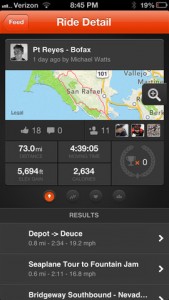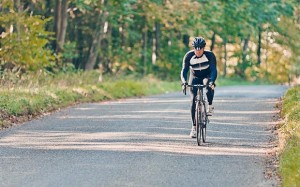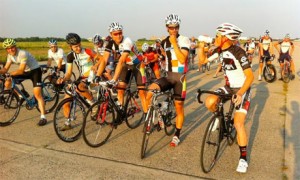The New Hegemonic Hierarchy: Tracking (Men’s) Athletic Activity
Post by Rebecca Feasey, Bath Spa University
 This post continues the ongoing “From Nottingham and Beyond” series, with contributions from faculty and alumni of the University of Nottingham’s Department of Culture, Film and Media. Today’s contributor, Rebecca Feasey, completed her PhD in the department in 2003.
This post continues the ongoing “From Nottingham and Beyond” series, with contributions from faculty and alumni of the University of Nottingham’s Department of Culture, Film and Media. Today’s contributor, Rebecca Feasey, completed her PhD in the department in 2003.
I have previously written on the representation of masculinity and the male role in popular television programming and considered the ways in which a range of friends, fathers, heroes and martyrs might be considered in relation to the hegemonic ideal. While the pinnacle of hegemonic masculinity speaks of a powerful, forceful and self-sufficient figure, demonstrating economic advantage and physical prowess, men on screen were seen to negotiate this particular ideal while continuing to demonstrate male dominance over their female counterparts. I concluded this work by suggesting that contemporary men ostensibly challenge the rigid codes of hegemonic power in favor of maintaining their hierarchical status, and nowhere is this more evident than in the emergence and development of the MAMIL.
The MAMIL (an acronym for the Middle-Aged Man In Lycra, hereafter Mamil) is a term recently used to describe a 40-something man who rides an elite road bike for leisure and pleasure, and who is styled in expensive, form-fitting, unforgiving and carefully picked sporting clothes and accessories. Contemporary commentary informs us that Mamils “do not simply go on an hour-long run out. Rides regularly last three hours or more, while in the spring and summer they disappear for days to ride in ‘sportive’ events.”
 What interests me here is not the UK’s Cycle to Work scheme (the government tax-exemption initiative introduced in 1999 to promote healthier journeys to work), the carbon-neutral footprint or even the sartorial efforts of the Mamils in question, bur rather, the use and abuse of Strava (and other available GPS systems) for this particular group. Strava, Swedish for “stride,” is a website and mobile app used to track athletic activity via GPS. It is proving incredibly popular with Mamils who can now pit themselves against friends, family and what are termed “followers,” irrespective of whether they are nipping to the local shops or doing the 874-mile “end-to-end” Land’s End to John o’ Groats–style challenge.
What interests me here is not the UK’s Cycle to Work scheme (the government tax-exemption initiative introduced in 1999 to promote healthier journeys to work), the carbon-neutral footprint or even the sartorial efforts of the Mamils in question, bur rather, the use and abuse of Strava (and other available GPS systems) for this particular group. Strava, Swedish for “stride,” is a website and mobile app used to track athletic activity via GPS. It is proving incredibly popular with Mamils who can now pit themselves against friends, family and what are termed “followers,” irrespective of whether they are nipping to the local shops or doing the 874-mile “end-to-end” Land’s End to John o’ Groats–style challenge.
Much contemporary work in masculinity studies tells us that men never openly discuss the hegemonic hierarchy or speak frankly or candidly about their position within it. Instead, men rely on markers of power and legitimacy to speak on their behalf. Promotions, company cars, updated business cards, expense accounts and designer accessories speak of wealth, and although physical mastery is clearly visible it is seldom a source of comment. However, the whole point of Strava seems to be the establishment of a more calculated, deliberate and exposed hierarchy of hegemonic masculinity based on the distance, pace and frequency of a rider. The Telegraph’s Matthew Sparkes tells us that:
Strava has forever changed cycling, for better or worse. The website tracks you via GPS and publicly ranks your best time on ‘segments’ of road along with other users. Now even a short trip to the supermarket has an element of competition […] if Strava ceases to exist you could lose a treasure trove of bragging rights fond memories.
He continues:
Email signatures are normally functional affairs reserved for job titles, phone numbers and addresses. But wouldn’t it be great if you could somehow use yours to show off the fact that you hold the (KOM) King of the Mountain across the local Tesco car park?
Later still, he asserts:
What is Strava for if not competing mercilessly with friends and colleagues? […] [E]nter your “athlete number” […] and that of one or more other riders. It then searches through the archives and finds segments that you’ve all recorded times for, laying out the results out for all to see.
One long-time cyclist says that Strava encourages competitiveness rather than healthy riding because the Strava team send the rider messages every time one of their KOM sections has been beaten:
Uh oh! Alex Morgan just stole your KOM!
Hey CyclingTips,
You just lost your KOM on Mt Rael Climb to Alex Morgan by 1 second.
Better get out there and show them who’s boss!
Your friends at Strava
Sparkes recommends that Mamils take the day off, leaving the GPS at home to enjoy “a ride at your own pace with nobody peering over your shoulder.” His words might appear hollow, though, to those men committed to the banter and bravado that Strava encourages:
Being a MAMIL, like all mid-life crises means acting like little boys. As 11-year-olds do, they have their in-jokes, asserting the perfect number of bikes to own is N + 1 (N is the number of bikes you have already). Another formula, which shows they are not entirely stupid, is S – 1 (S is the number of bikes that will prompt your wife to demand a separation).
It is commonplace for friends and acquaintances to offer kudos to one another after a successful ride. Such kudos might serve as a mark of respect for fellow cyclists, but it can also be read as one more way of marking hierarchies for the 40-something Mamil. The Mamil proposes a new take on the old masculine hierarchy. While it’s easy to mock, deride or undermine earlier iterations of hegemonic masculinity for their commitment to body sculpting, excessive hours spent in the office, or ostentatious soft-top cars or the motorcycling equivalent, it is harder to challenge the eco-friendly, physically fit Mamil. This is precisely why these new figures of contemporary masculinity are such skillful hegemonic creations.
Hegemonic masculinity has routinely relied on masculine camaraderie and jovial banter at the expense of women, and the Strava Mamil continues this bromantic scenario, but for a wider, invested and interested audience. Indeed, there is no Queen of the Mountain accolade. Nor is this phenomenon restricted to the UK. As one Wall Street banker puts it:
Every day, bankers check the league tables, a scoreboard that shows who won the biggest deals. Then they check their Strava app to see who’s chewing up the pavement fastest on his $20,000 bike. That’s recreation on Wall Street. […] We like to push ourselves. And it’s not ’80s Wall Street. We’re not out buying Lamborghinis and paying for coke habits. We’re buying $10,000 bikes.
Fitness-culture discourse frames Strava as a “hotly contested virtual race of it’s [sic] own where Stravaddicts are venturing out on rides with the sole intent of sniping segments for themselves and claiming the top of the leaderboards.” While Strava puts discourses of competitive fitness in niche circulation, it also bolsters persistent male hegemony.


